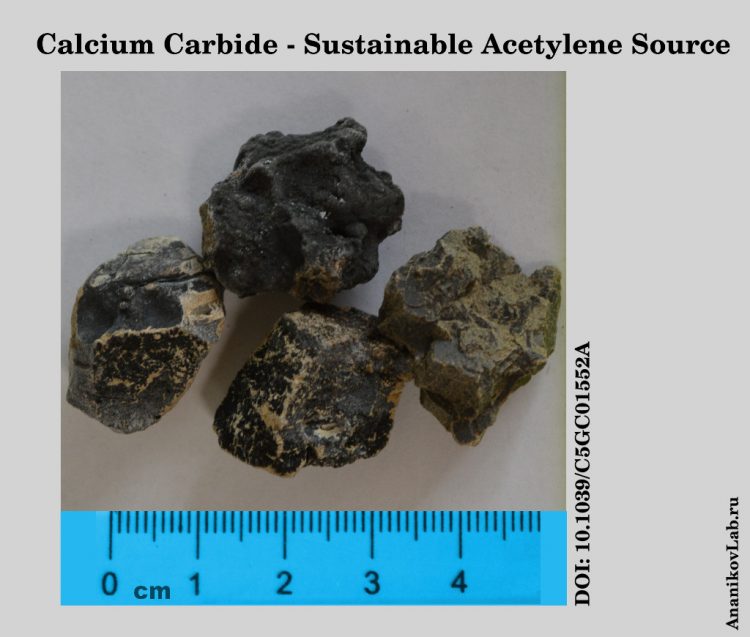New life of old molecules: Calcium carbide

Unremarkable gray "pebbles" of calcium carbide -- valuable material for science and industry. Copyright : Ananikov Laboratory (AnanikovLab.ru)
Over the last few decades, researchers have focused their attention on very large molecules and molecular systems. Scientists from all over the world study proteomics, genomics, construct complex proteins, nucleic acids, decode the genomes of entire organisms, and design new sub-cellular structures.
Outstanding enthusiasm for these important and essential areas of science has become so widespread that the question arose: “Is there a place for small organic molecules in modern science?” It might seem that old and well-known small organic molecules, as well as some areas of classical organic chemistry, have been forgotten.
Remarkably, despite the above mentioned trend of mega-molecules, state-of-the-art research anticipates re-investigation of tiny molecules. Indeed, small molecules carry a huge and previously unrevealed potential for science and industry. Renaissance in this area of science initiated an enlightenment of the well-known small molecules. An example of a small molecule is acetylene and derivative of acetylene – CaC2 or calcium carbide.
Friedrich Wohler first introduced the prominent calcium carbide in 1862. As a matter of fact, this breakthrough revolutionized the lighting in the 20th century Europe and US. The manufacture of carbide reached thousands of tons by the middle of the last century. Such an increase was caused by the fact that carbide was mainly used for the production of acetylene. Nevertheless, the end of carbide lamps era came with the advent of safer electric light sources. The development of catalysis and petrochemistry introduced cheaper acetylene sources, so calcium carbide was left behind.
An innovative method, proposed by a group of researchers led by Professor Ananikov, investigates the synthesis of valuable organic molecules directly from calcium carbide, without separation and storage of acetylene gas. As an example, thiovinylation reaction occured directly in the reaction mixture. Firstly, acetylene is allocated from calcium carbide and water, and secondly, thiol molecules get attached to the acetylene molecules. Both processes take place one-pot and do not require sophisticated equipment. The use of calcium carbide not only fundamentally simplifies and reduces the cost of synthesis, but also avoids the problems associated with transporting, storing, and handling of acetylene gas.
The developed process gives a vivid example of successful replacement of dangerous and difficult to handle acetylene gas by a simple and inexpensive calcium carbide. If the further research manages to carry out the chemistry of acetylene utilizing carbide-based technologies, the proposed method will open a new direction in organic chemistry. Without a doubt, the “little” calcium carbide will find its a place in modern chemistry, which acknowledges the ideas of safety, sustainability, and simplification.
The article «Efficient Metal-Free Pathway to Vinyl Thioesters with Calcium Carbide as the Acetylene Source» by Konstantin Rodygin and Valentine P. Ananikov was published in Green Chemistry journal by the Royal Society of Chemistry.
Reference: Green Chemistry, 2015; DOI: 10.1039/C5GC01552A
On-line link: http://dx.doi.org/10.1039/C5GC01552A
Associated links
http://dx.doi.org/10.1039/C5GC01552A
http://AnanikovLab.ru
Media Contact
More Information:
http://www.researchsea.comAll latest news from the category: Materials Sciences
Materials management deals with the research, development, manufacturing and processing of raw and industrial materials. Key aspects here are biological and medical issues, which play an increasingly important role in this field.
innovations-report offers in-depth articles related to the development and application of materials and the structure and properties of new materials.
Newest articles

Bringing bio-inspired robots to life
Nebraska researcher Eric Markvicka gets NSF CAREER Award to pursue manufacture of novel materials for soft robotics and stretchable electronics. Engineers are increasingly eager to develop robots that mimic the…

Bella moths use poison to attract mates
Scientists are closer to finding out how. Pyrrolizidine alkaloids are as bitter and toxic as they are hard to pronounce. They’re produced by several different types of plants and are…

AI tool creates ‘synthetic’ images of cells
…for enhanced microscopy analysis. Observing individual cells through microscopes can reveal a range of important cell biological phenomena that frequently play a role in human diseases, but the process of…





















